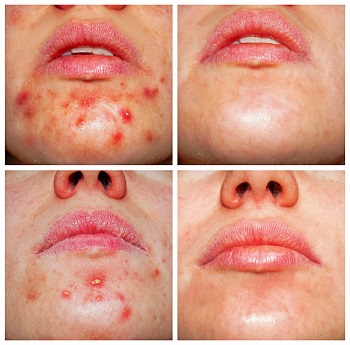What Causes Adult Acne? 6 Hidden Triggers and How to Clear Your Skin
Quick Answer: Adult acne affects 40-55% of people over 25 and is usually triggered by hormonal changes, stress, wrong skincare products, or lifestyle factors. Unlike teenage acne, adult breakouts typically appear on the lower face, jawline, and neck. The good news? Most adult acne improves within 6-12 weeks with targeted treatments designed for mature skin.
You thought acne was something you'd left behind in high school. Yet here you are, dealing with breakouts in your 30s, 40s, or even 50s—and feeling embarrassed about something that seems so "teenage."
You're definitely not alone. Adult acne is incredibly common, affecting more women than men, and it's often more stubborn than teenage breakouts. But understanding what's causing your adult acne is the first step to finally getting clear skin.
What Actually Is Adult Acne?
Adult acne is any acne that develops or persists after age 25. It typically appears as inflammatory bumps, cysts, or deep nodules rather than the blackheads and whiteheads common in teenage years.
Adult acne usually shows up in a "U-shaped" pattern around your lower face, jawline, chin, and neck—areas where hormonal fluctuations have the biggest impact on oil production.
The 6 Most Common Adult Acne Triggers
1. Hormonal Fluctuations
The biggest culprit. Hormonal changes during menstrual cycles, pregnancy, perimenopause, or from conditions like PCOS cause oil glands to produce excess sebum.
2. Chronic Stress
Stress increases cortisol levels, which triggers inflammation and oil production. This is why you often break out during high-pressure periods at work or major life changes.
3. Wrong Skincare Products
Many adult skincare routines are too harsh or contain pore-clogging ingredients. Products designed for teenage skin can actually worsen adult acne by over-drying mature skin.
4. Lifestyle Factors
Poor sleep, processed foods high in sugar, dairy consumption, and inadequate hydration can all trigger inflammatory responses that worsen acne.
5. Hair and Makeup Products
Heavy conditioners, styling products, or makeup that contain comedogenic (pore-clogging) ingredients can trigger breakouts along your hairline and jawline.
6. Medical Conditions or Medications
PCOS, thyroid disorders, or medications like corticosteroids and lithium can cause persistent adult acne as a side effect.
When Should You See a Doctor?
Consider professional help if you experience:
- Cystic or nodular acne (deep, painful bumps)
- Acne scars forming from current breakouts
- Sudden onset of severe acne in adulthood
- Acne with other symptoms like irregular periods, excessive hair growth, or weight gain
- No improvement after 6-8 weeks of consistent treatment
- Emotional impact affecting your confidence or daily life
A dermatologist can prescribe stronger treatments and rule out underlying hormonal conditions.
7 Treatments That Actually Work for Adult Acne
1. Gentle, Consistent Cleansing
Use a mild, non-drying cleanser twice daily. Adult skin needs gentle care, not aggressive scrubbing that can worsen inflammation.
2. Salicylic Acid (BHA)
2% salicylic acid products penetrate pores and reduce inflammation without over-drying mature skin. Use 3-4 times per week initially.
3. Retinoids
Over-the-counter retinol or prescription tretinoin are gold-standard treatments that prevent clogged pores and improve skin texture. Start slowly to avoid irritation.
4. Benzoyl Peroxide (Lower Concentrations)
2.5% benzoyl peroxide kills acne bacteria effectively with less irritation than higher concentrations. Use as spot treatment initially.
5. Hormonal Balance Support
For hormonal acne, spearmint tea, omega-3 supplements, or zinc can help balance hormone levels naturally.
6. Professional Treatments
Chemical peels, LED light therapy, or professional extractions can accelerate clearing for stubborn cases.
7. Stress Management
Regular exercise, adequate sleep (7-9 hours), and stress-reduction techniques like meditation can significantly improve hormonal acne.
Adult Acne Prevention Tips
Daily Skincare Routine:
- Morning: Gentle cleanser → vitamin C serum → moisturizer → SPF 30+
- Evening: Gentle cleanser → treatment (retinol/salicylic acid) → moisturizer
Lifestyle Adjustments:
- Change pillowcases weekly
- Clean phone screen daily
- Avoid touching your face
- Remove makeup completely before bed
- Stay hydrated (8 glasses water daily)
Dietary Considerations:
- Reduce dairy and high-glycemic foods
- Increase omega-3 rich foods (salmon, walnuts)
- Limit processed sugar and refined carbs
- Consider probiotic foods for gut health
Products That Actually Work
For Gentle Daily Care:
- CeraVe Foaming Facial Cleanser (non-comedogenic, gentle for daily use)
- Paula's Choice 2% BHA Liquid Exfoliant (effective salicylic acid without irritation)
- Neutrogena Hydrating Foaming Cleanser (budget-friendly, gentle option)
For Treatment:
- Differin Gel (over-the-counter retinoid, specifically for acne)
- The Ordinary Niacinamide 10% + Zinc 1% (reduces oil production and inflammation)
- La Roche-Posay Effaclar Duo (benzoyl peroxide + niacinamide combination)
For Hormonal Support:
- Traditional Medicinals Spearmint Tea (natural anti-androgen properties)
- Nordic Naturals Omega-3 (high-quality fish oil for inflammation)
- Thorne Zinc Bisglycinate (well-absorbed zinc for hormone balance)
For Mature Skin:
- Olay Regenerist Micro-Sculpting Cream (moisturizes without clogging pores)
- EltaMD UV Clear SPF 46 (broad-spectrum protection, niacinamide included)
The Bottom Line
Adult acne is frustrating, but it's also completely treatable. The key is understanding that adult skin needs different care than teenage skin—gentler products, consistent routine, and often addressing underlying hormonal or lifestyle factors.
Most people see significant improvement within 6-12 weeks of starting an appropriate routine. Be patient with your skin, focus on gentle consistency rather than harsh quick fixes, and don't hesitate to seek professional help if over-the-counter treatments aren't working.
Remember: having adult acne doesn't mean you're doing anything wrong. Your skin is simply responding to internal and external factors that are often beyond your immediate control.
This information is for educational purposes only and is not intended as medical advice. If you have persistent symptoms or concerns, consult with a healthcare provider or dermatologist for proper diagnosis and treatment.
